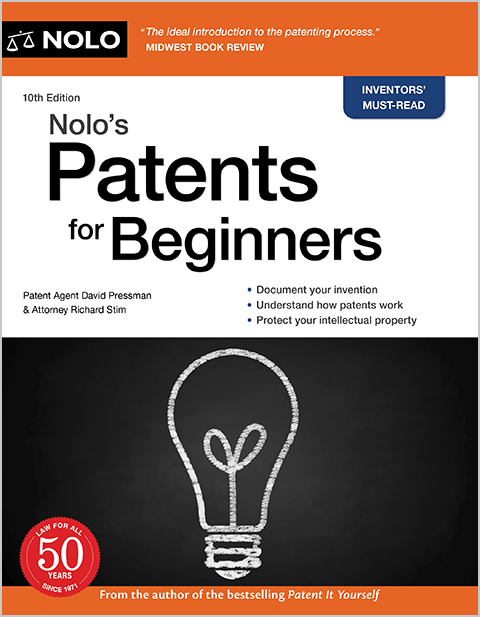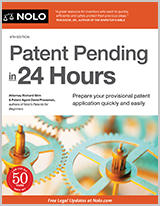Inventors' must-read!
Nolo's Patents for Beginners
- Product Details
- document an invention
- "read and write" patents
- understand how and why to make a patent search
- determine patent ownership
- acquire patent rights
- understand the basics of patent infringement
- get international patent protection, and
- decide whether to file a provisional patent.
- About the Author
- Table of Contents
- What Is a Patent?
- The Three Types of Patents
- Patent Rights
- The Requirements for Obtaining a Patent
- How Long Do Patent Rights Last?
- How Patent Rights Can Be Lost
- Intellectual Property-The Big Picture
- Trademarks
- Copyright
- Trade Secrets
- Unfair Competition
- Legal Requirements for a Utility Patent
- Statutory Classes
- Utility
- Novelty and Prior Art
- Nonobviousness
- Design Patent Requirements
- Plant Patent
- The Importance of Documentation
- Lab Notebook
- Invention Disclosure
- Trade Secret Considerations
- Principles of Patent Searching
- Hiring a Patent Searcher
- Do It Yourself Searching
- Elements of a Patent
- Invention and Inventor Data
- Specification
- Claims
- Abstract
- Drawings
- Preparation of a Patent Application
- Specification (Including Description, Claims, and Abstract) and Drawings
- Electronic Filing (The EFS System)
- Patent Prosecution: The Road to Allowance
- Responding to a Final Office Action
- Additional Application Issues
- Design Patent Prosecution
- The Inventor Is Initial Owner of Patent Rights
- Employee Inventions
- Joint Owners
- What Is Patent Infringement?
- Who Can Sue, Who Can Be Sued?
- Stopping Patent Infringement
- Defenses to Patent Infringement
- Ending Disputes Without a Lawsuit
- Introduction to Foreign Patent Treaties and Laws
- Putting It Together: The Most Common Route for U.S. Inventors Seeking Foreign Patent Coverage
- The Paris Convention and the One-Year Foreign Filing Rule
- The Patent Cooperation Treaty (PCT)
- European Patent Office (EPO)
- Locating Foreign Patent Agents
- Inventor Resources
- Patents and Intellectual Property Resources
- Working With an Attorney
- Sample Chapter
- Principles of patent law. The first two chapters explain basic patent principles, the types of patents, the innovations that can and cannot be protected, novelty, nonobviousness, and the statutory standards for patent protection.
- Documenting, searching, and prosecuting patents. Chapter 3 describes invention documentation. Chapter 4 describes patent searching, and Chapter 5 describes how to read and write a patent application. Chapter 6 describes patent prosecution—the process of shepherding the patent application through the PTO.
- Ownership and patent disputes. Chapter 7 provides information about ownership rights (for example, how inventors claim joint ownership and its implications). Chapter 8 focuses on the issues of litigating patent disputes and standards for patent infringement.
- International law. Chapter 9 provides rules for international patent protection.
- Resources. We have provided a Glossary to assist in deciphering patent law. Additionally, Chapter 10 offers additional inventor and patent resources.
This bestselling primer is packed with everything inventors need to know about patent law basics, including the latest implications of the America Invents Act, the most important change to American patent law in two centuries.
Nolo's Patents for Beginners helps inventors:
You’ll also find patent and invention resources and a glossary of patent terms. This new edition is completely updated to cover all the latest changes in patent law and regulations.
"Will help minimize legal fees by preparing you to do what you can for yourself..." - Dallas Morning News
"The ideal introduction to the patenting process." - Bookwatch
Your Legal Companion
1. Patents and Intellectual Property Law
2. Qualifying for a Patent
3. Invention Documentation
4. Patent Searching
5. Reading and Writing Patents
6. Patent Prosecution and the PTO
7. Patent Ownership
8. Patent Infringement
9. International Patent Law
10. Help Beyond This Book
Glossary
Index
Your Legal Companion
The title of this book may have you wondering. Can patents—an area of law filled with arcane terminology, strange rules, and scientific jargon—really be reduced to a beginner’s level?Don’t fear. We’re convinced that with a little diligence, anyone can understand the basics of patent law.
Keep in mind that the major principle underlying patent protection has not changed since 1790. If you devise something new and it qualifies for a patent, you can, for a limited time, prevent anyone else from making, selling, or using it. However, the technological changes of the past 25 years have dramatically altered the patent landscape. The number of utility patent applications has nearly tripled since 1980. In all, more than ten million patents have been granted since the United States began its patent program in 1790. (Patent numbering didn’t begin until 1836.)
Patents are now considered an integral part of a corporation’s strategic business plan. And this strategy is not limited to corporate boardrooms. For example, the total revenue for university patents has gone from less than one million dollars in 1980 to more than half a billion dollars today.
The patent system has also become far more accessible than it was two decades ago. You can now search patent records at the U.S. Patent and Trademark Office (PTO), on Google, or at many other websites. Patent forms and rules can now be easily downloaded, and patents and other documentation can be filed online.
To stay current with the modern world of patents, we have created a compact modern patent guide that explains patent law and provides clear instructions for deciphering and searching for patents. This book is intended for use by inventors, educators, entrepreneurs, students, non-patent attorneys, and businesspeople who must deal with and understand basic principles of patent law.
Chapters are organized into four categories: basic patent principles, rules for documenting and acquiring patent rights, patent ownership and disputes, and international patent law (Chapter 10 provides helpful resources):
An instructor using the book as a teaching tool can proceed systematically through the chapters beginning with principles of protection, followed by patent application principles, and culminating with patent disputes and international patent law. For students, the material includes current case law, references, and examples.
|
Get Updates and More Online When there are important changes to the information in this book, we’ll post updates online, on a page dedicated to this book: www.nolo.com/back-of-book/QPAT.html |

